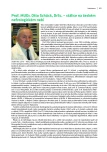Prevalence of microalbuminuria in patients with diabetes mellitus in the Czech Republic: Project IDN-Micro
Authors:
Ondřej Pátek; Miroslava Horáčková; Milan Kvapil
Authors‘ workplace:
Interní klinika 2. LF UK a FN v Motole, Praha
Published in:
Vnitř Lék 2016; 62(Suppl 6): 21-24
Category:
Original Contributions
Overview
Introduction:
Prevalence of a positive testing for microalbuminuria (MA) in patients with diabetes mellitus in the Czech Republic is not described in the available literature. The data is important with regard to monitoring effectiveness of the comprehensive therapy for diabetes mellitus, from the prognostic and pharmacoeconomic perspective.
The aim of the study was to assess the prevalence of presence of microalbuminuria or proteinuria (PU) in randomly chosen patients with diabetes mellitus aged up to 65 years in a cross-cutting study. The secondary aim was to assess the distribution of eGFR (estimated glomerular filtration) in the same population.
Methodology:
2 024 patients with diabetes aged up to 65 years were examined within the project. The median of diabetes duration was 6.0 years, the BMI median was 30.7 kg/m2, the creatinine median 74.9 µmol/l, the median of HbA1c 5.45 %, the blood pressure median 132/80 mm Hg. 1 888 patients had type 2 diabetes (DM2T).
Results:
19.96 % of the examined patients tested positive for MA (24.24 % of them with type 1 diabetes – DM1T, 19.16 % DM2T). 11.36 % tested positive for PU (17.78 % DM1T, 10.21 % DM2T). Glomerular filtration was established through calculation (MDRD), with a normal value identified in 44.7 %, a mild decrease (eGFR 1.0–1.49 ml/s) in 46.7 %, medium (eGFR 0,5–0,99 ml/s) in 7.7 %, and a severe decrease (eGFR < 0.5 ml/s) identified in 0.7 %, hemodialysis in 0.2 %. The median of diabetes duration in MA-negative patients was 5 years, in MA-positive patients 7 years and in patients with proteinuria 11 years. Regarding patients with eGFR between 0.5–0.99 ml/s/1.73 m2, 63.23 % of them tested negative for MA and 71.62 % for PU, regarding those with eGFR in the range of 0.25–0.49 ml/s/1,73 m2, 15.38 % tested negative for MA and 7.69 % were PU-negative.
Conclusion:
The IDN-Micro project shows high prevalence of positive MA and PU findings in individuals with diabetes mellitus younger than 65. For a significant proportion of individuals, the most likely cause of the decrease in eGFR is other than hyperglycemia. It is apparent that examination of serum concentrations of creatinine and evaluation of eGFR is also necessary for relatively younger patients with diabetes.
Key words:
diabetes mellitus – eGFR – microalbuminuria
Sources
1. McCullough PA, Bakris GL, Owen WF Jr et al. Slowing the progression of diabetic nephropathy and its cardiovascular consequences. Am Heart J 2004; 148(2): 243–251.
2. Mogensen CE, Christensen CK, Vittinghus E. The stages in diabetic renal disease. With emphasis on the stage of incipient diabetic nephropathy. Diabetes 1983; 32(Suppl 2): S64-S78.
3. Bakris GL. Recognition, pathogenesis, and treatment of different stages of nephropathy in patients with type 2 diabetes mellitus. Mayo Clin Proc 2011; 86(5): 444–456. Dostupné z DOI: <http://dx.doi.org/10.4065/mcp.2010.0713>.
4. Warram JH, Scott LJ, Hanna LS et al. Progression of microalbuminuria to proteinuria in type 1 diabetes: nonlinear relationship with hyperglycemia. Diabetes 2000; 49(1): 94–100.
5. Kvapil M. Význam farmakologické intervence diabetické nefropatie ve vztahu k epidemiologickým důsledkům. Farmakoterapie 2013; 9(6): 661–664
6. Svensson MK, Cederholm J, Eliasson B et al. [Swedish National Diabetes Register]. Albuminuria and renal function as predictors of cardiovascular events and mortality in a general population of patients with type 2 diabetes: a nationwide observational study from the Swedish National Diabetes Register. In: Abstracts of the 46th General Assembly of the European Association for the Study of Diabetes (EASD). Stockholm, Sweden. September 20–24, 2010. Diabetologia 2010; 53(Suppl 1): S473.
7. Ahn SH, Susztak K. Getting a notch closer to understanding diabetic kidney disease. Diabetes 2010; 59(8): 1865–1667.
8. Ruggenenti P, Fassi A, Ilieva AP et al. Preventing Microalbuminuria in Type 2 Diabetes. N Engl J Med 2004; 351(19): 1941–1951.
9. Brenner BM, Cooper ME, de Zeeuw D et al. Effects of losartan on renal and cardiovascular outcomes in patients with type 2 diabetes and nephropathy. N Engl J Med 2001; 345(12): 861–869.
10. Lewis EJ, Hunsicker LG, Clarke WR et al. Renoprotective effect of the angiotensin-receptor antagonist irbesartan in patients with nephropathy due to type 2 diabetes. N Engl J Med 2001; 345(12): 851–860.
11. Silveiro SP, Araújo GN, Ferreira MN et al. Chronic Kidney Disease Epidemiology Collaboration (CKD-EPI) equation pronouncedly underestimates glomerular filtration rate in type 2 diabetes. Diabetes Care 2011; 34(11): 2353–2355. Dostupné z DOI: <http://dx.doi.org/10.2337/dc11–1282>.
12. Škrha J. Diabettes mellitus 2002 v České Republice – Epidemiologická Studie. DMEV 2005; 8(1): 5–12.
13. Ústav zdravotnických informací a statistiky ČR. Dostupné z WWW:
14. Doporučený postup péče o diabetes mellitus 1. typu. Dostupné z DOI: <http://www.diab.cz/dokumenty/standard_dm1_12.pdf>.
15. Agoons DD, Balti EV, Kaze FF et al. Performance of three glomerular filtration rate estimation equations in a population of sub-Saharan Africans with Type 2 diabetes. Diabet Med 2016; 33(9): 1291–1298. Dostupné z DOI: <http://dx.doi.org/10.1111/dme.12996>.
16. de Boer IH, Rue TC, Hall YN et al. Temporal trends in the prevalence of diabetic kidney disease in the United States. JAMA 2011; 305(24): 2532–2539. Dostupné z DOI: <http://dx.doi.org/10.1001/jama.2011.861>.
17. Pavlík T, Klika P, Kovalčíková P et al. Základní analýza údajů o pacientech s diabetes mellitus. DMEV 2015; 18(Suppl 1): 21.
Labels
Diabetology Endocrinology Internal medicineArticle was published in
Internal Medicine

2016 Issue Suppl 6
Most read in this issue
- Metabolic acidosis in chronic kidney disease
- Current options of treatment of hyponatremia
- Gitelman´s syndrome as common cause of hypokalemia and hypomagnesemia
- Osteoporosis – epidemiology and pathogenesis
